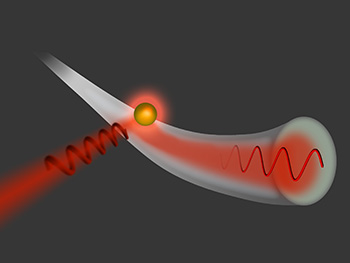
Scientists directed laser light onto a gold particle, which then emitted light into a glass fiber—but only in one direction. Credit: TU Wien
A team of materials researchers at the Vienna Center for Quantum Science and Technology at TU Wien–Atominstitut (Austria) has demonstrated a new effect that enables control of the direction of emission of light of nanoparticles in tiny optical fibers, which holds promise for transforming integrated information processing via optical novel sensing schemes and integrated optical circuits (Science, doi: 10.1126/science.1257671).
Doctoral candidate Jan Peterson and colleagues broke the mirror symmetry of light scattering by coupling photon spin (related to the rotation of the light wave) to the direction of light propagation. This control of spin-orbit coupling enables almost lossless coupling of light into and out of a nanofiber from standard optical fiber. To do this, they placed a gold nanoparticle 90 nm in diameter on an optical fiber with a diameter of approximately 300 nm (less than the wavelength of the guided light) and adjusted the polarization of the incident light to control its emission. They found that 94 percent of the nanoparticle emission can scatter to the left or right of the direction of the fiber, creating a chiral waveguide coupler in which the left- or right-handedness of the incident light determines the propagation direction in the waveguide.
The strong transverse confinement of the guided photons is what causes the coupling of internal spin and orbital angular momentum, according to coauthor Jürgen Volz, assistant professor of optics and photonics at the Center.
“Such an effect could enable new, highly miniaturized devices of less than a cubic millimeter that can control light at nanometer wavelengths, an important prerequisite for optical integrated circuits,” said Volz. Furthermore, the results could enable novel optical sensing schemes, where the scattering asymmetry could be used to identify particles passing through the evanescent field of the fiber.
The team is planning improvements to the scheme that would allow efficiencies comparable to that in standard optical telecom components.
